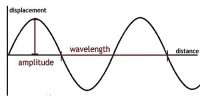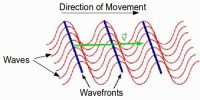Experiment for the production of stationary wave:
Attach a scale pan at one end of a string taken over a pulley. Attach the other end of the string with the arm of a tuning fork. Put some weight on the scale pan. You will see that the string is stretched. Now strike the tuning fork.

A progressive wave is produced when a tuning fork is vibrated [Figure] and progressing along the string is reflected from the other end of the string. Due to the superposition of the incident and reflected waves stationary wave is produced. By changing the weights on the scale pan distinct nodes and antinodes can be seen.
The phase variations between the two waves narrows. The resultant grows but is not in phase with either of the two waves. The phase dissimilarity between the two waves is narrower still. The resultant is bigger but is still out of phase with the two waves. The phase difference between the two waves is now zero. The resultant has its utmost value and is in phase with the two waves. These ‘in phase’ waves produce amplitude that is the sum of the individual amplitudes, the region being called antinodes. Between two antinodes is a region where the superposition is zero. This is called a node.
In conclusion, standing wave patterns are produced as the result of the repeated interference of two waves of equal frequency while moving in reverse directions along the similar medium. All standing wave patterns consist of nodes and antinodes. The nodes are points of no displacement caused by the destructive interference of the two waves.
















